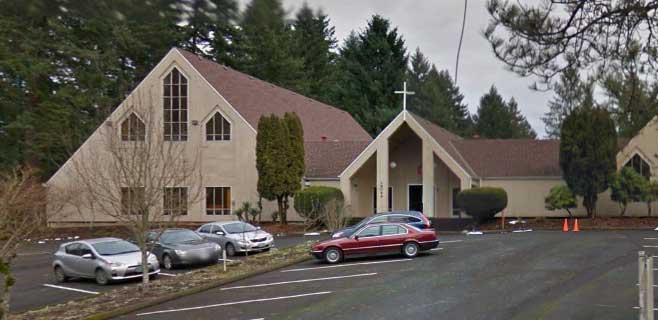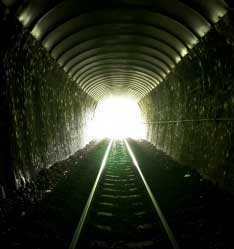A Monumental Story: Lake Bible Church
 Printable versions of the content below are available in for download in two formats. If you have access to two page printing, you can download the booklet version which can be folded into a half-page booklet. If you will be printing single sided or would prefer to not have a folded booklet, you can download the standard file. Both versions print on standard US letter paper.
Printable versions of the content below are available in for download in two formats. If you have access to two page printing, you can download the booklet version which can be folded into a half-page booklet. If you will be printing single sided or would prefer to not have a folded booklet, you can download the standard file. Both versions print on standard US letter paper.Two Became One
Lake Bible Church was born on a fairway. Well, sort of. Once upon a time, two golfers, pastors of the tiny Rivergrove and Lake Grove Baptist churches, proposed a marriage of their two churches. Shortly thereafter, the two bodies were engaged and finally united on February 4, 1979. Their married name became Lake Baptist Church. The newlyweds made their home at the old Rivergrove church on Pilkington.

Unlike many marriages, this one worked. The two ministers served as co-pastors until 1981. At that time, the older of the two was winding down and considering retirement. The younger was sensing the call of God to another ministry.
Growth Surge

“If price were no consideration, where would be the best church site in Lake Oswego?”
In 1982, Lake called a young minister from Texas to serve as it’s senior pastor. His impact was immediate and attendance initially surged. The burst of growth soon taxed the small Pilkington church. Sunday services were packed, the educational facilities were over-crowded, and the hallways were plugged. A new building was the obvious answer.
Hence, in 1982, a group was established to study the possibility of building. While need was pressing, the necessary capital was lacking. Inquiries turned up no desirable sites that were even remotely affordable. Eventually, eliminating cost as a consideration, the group asked themselves, “If price were no consideration, where would be the best church site in Lake Oswego?”
After some study, the obvious choice was the corner of Kruse Way and Carman Drive. However, the same factors that made this the site of choice; freeway accessibility, demographics, visibility, and so forth, had also boosted the land prices in the area as high as $6-8 per square foot or $350,000 per acre. With the church needing 8-10 acres at a minimum, prospects for that property were dim. Still, it costs nothing to ask. So, ask they did.
Light at the End of the Tunnel

To their surprise, Mrs. Pearl Kruse, the owner, expressed a desire to work something out. As she was then over 80 years of age, estate considerations were a factor for her and would play an important role in the ensuing negotiations.
But major hurdles lay just ahead. Seeing it’s obvious potential, commercial interests also had an eye on the property. During the course of the church’s negotiation for the land, which lasted over a year, a large national retailer sought the property for one of it’s stores. This proposal promised a far more lucrative deal for the owner, provided the prospective buyer could get the property rezoned for commercial use.
The outcome was in doubt for several months as the owner weighed her options. In the end, God used the echo of her deceased husband’s wishes to settle the matter in Lake’s favor. Mr. Kruse had always told his wife that he didn’t ever want a “beer joint” located on that land. Her concern to honor his desire apparently played a role in her final decision to enter into an agreement with Lake. God can turn the most insignificant things to serve His purposes.
Monument One
…with more to come
Even the history of the land reveals the hidden hand of God working out His purpose well before the church was even born.
The Kruse property had been in the family for generations, and may have been an original land grant from the government. In any case,in the 1960’s, the family sold the majority of the adjacent land to the Mormons. Word had it that their plan was to establish a western branch of Brigham Young University. For some reason, however, they sold it to a Canadian developer who eventually defaulted. Asked why Mr. Kruse failed to include our parcel in the original Mormon package, nobody knew. For unspecified reasons, he elected to hold back the plot we now occupy.
Concealed behind our whimsical impulses is often the Sovereign Prompter whose purpose we unconsciously serve as He weaves His complex design.
A Little Buys a Lot
The terms of the lease agreement, again, highlight the provision of God. With its non-commercial zoning at that time, the property was valued at roughly $500,000. That meant that just to hold the property, pending development, interest costs alone (at 10-12%) would run $50,000 to $60,000 per year. Never could the church at that time have afforded it. However, as it turned out, Mrs. Kruse negotiated an agreement with the church that enabled it to hold the land for the relatively modest sum of approximately $9,000 per year!
Monument Two
…what else will God do?
God’s blessings seldom bestow upon us the luxury of long reprieves before new burdens descend upon us.
From Agony to Ecstasy
After securing the land lease, the city advised the church of it’s desire to put a road through the property to facilitate traffic flow in the new housing areas being developed. This, of course, compromised our siting situation, so the church resisted the plan. At this time, the Mormons suddenly claimed to own first right of refusal to buy our property. It turned out that they could never produce documentation to support this claim and this obstacle was averted. The upshot was that Lake eventually consented to allow the city to cross it’s land, permitting the proposed road to intersect with the Fosberg and Carman intersection. In turn, we were able to make a pact with the Mormons to trade portions of our two properties.
The resulting configuration was mutually beneficial. As part of the deal, we received a small strip of land that separated our original property from Kruse Way, as well as an additional 35 feet of land to use to the west. What initially seemed to pose insurmountable obstacles, resolved into an agreement that provided the church with better siting, better parking, good access, and traffic flow much superior to the original plan.
Monument Three
…God, hear our plea.
God’s blessings seldom bestow upon us the luxury of long reprieves before new burdens descend upon us.
From Agony to Ecstasy
Sometimes the vexatious obstacles God allows amount to nothing more than benign diversions to a better way. Moreover, strategic delays are just a providential mechanism to facilitate the conjunction of all the elements of His plan at just the right time.
A Severe Mercy
Even so, whoever expected that God would delay the dream for eight long years from the time the property was secured? In retrospect, the divine deferral was clearly a mercy from an all-knowing God who put us off until our house was in order. As things developed, it probably would have been the undoing of Lake had the church undertaken a building project in the intervening years. The frictions of church construction can generate sparks that set off fiery dissension. In that case, the unfortunate outcome is that the solution to one problem precipitates a worse one.
The elders worked on the premise that if they could find ways to maximize the pastor’s strengths, minimize his weaknesses, and appease his critics, the work might really flourish. Many saw these intermittent tensions as just the normal process of adjusting to a new style of pastoral leadership. Optimistically, they anticipated that a new church would usher in a new era of enthusiasm and forgetfulness and that the grumbling would melt away in the euphoria of explosive growth and ministry opportunity. So, fortunately, planning for a new building proceeded amidst all this distraction.
A Church Leaves Home
The overcrowding situation at Pilkington simply would not wait for a new building. In the first place, the church needed the proceeds from the property as seed money for the project. Moreover, financial capacity depended on additional growth, which was presently impossible at Pilkington. Hence, the idea of moving out into more spacious interim quarters was broached. Also favoring such a move was the theory that temporary quarters might make it easier to motivate the congregation to do what was necessary to get the building program moving. So the church property was put up for sale. It took a while, but eventually, the property sold and the congregation took up temporary occupancy in 1987 at Waluga Junior High School on Jean Road less than a mile from the old church.
Three years later it was still meeting there and a building was no where in sight when in mid-March of 1990, the senior pastor abruptly resigned. His unexpected resignation marked a turning point. Somehow, the church started to find its better self, stabilize, unite, and get itself on track. But that outcome was not so certain initially.
Turning Point

As could be expected, some of the staff and congregation were shaken from the pastor’s sudden departure.
That could have been a flash point. Had those sparks set off an emotional conflagration, Lake today might have been history. For the church seemed given to upsets, a trait all too common in Baptist churches. Up to this point, the ethos of Lake was more that of a casual crowd than a tight-knit church. For some reason, the church had never really bonded in the way solid churches do. Thus, the congregation as a whole manifested little sense of ownership. Yet in the midst of the crowd was a persevering core who acted as the cement that held things together under centrifugal conditions. Through crisis God often checks out attitude before He gives us altitude.
Timely Help in the Wings
Within three weeks, the elders invited Jim Andrews, then a professor at Western Seminary and former pastor who had been attending Lake, to take the helm on an interim basis. His availability at this critical time was itself a stroke of providence.
Things soon stabilized nicely, unity was restored, and harmony, once again graced the atmosphere. As was expected, within the next 15 months most of the previous staff gradually stepped down. The refreshing thing was that none of the partings further troubled the waters. All were voluntary and amicable.
A Close Call
Meanwhile, amidst all the distraction, another threat was sneaking up on the church. This problem could literally have forced our disbandment or some sorry solution that might have had approximately the same effect. At the time of the pastoral change in March, it so happened that the church had only three months remaining in it’s non-renewable lease with Waluga Junior High School. Although this was known, little progress had been made in securing a viable alternative. Suddenly, the heat was on big time. Efforts to locate a workable and affordable facility in Lake Oswego, one with the necessary seating and parking capacity, were in vain. Not even in adjacent communities could anything be found. The meter was running and Lake was down to three days until D-day with no realistic solution in sight, but God has the tendency not to save the bacon until it’s crisp.
One day out of the blue and from two independent directions and almost simultaneously came a rumor of a facility down in Wilsonville that just might be the ticket. The building had formerly housed a lumber brokerage business. Amazingly, its configuration seemed designed for a church as a secondary use. What’s more, the site provided sufficient parking to boot!
Oh, it wasn’t perfect by any means. It was about 8 miles south of Lake Oswego and at that time, a tad beyond our natural ministry area. Yet even that liability the Lord used positively. The extra commitment it took to get down there seeded the hearts of the faithful with a greater sense of ownership. Lack of that attribute (on a broad basis) had up to that time been one of Lake’s downfalls. Still, on balance the place was far superior to any temporary facility we were likely to find anywhere in the area, was affordable, and, unlike the school, available to us on a seven-day-a-week basis. But it was still a reach. The biggest sticking point was the industrial zoning. For a church to occupy the facility would require a temporary conditional use permit and potentially costly improvements to bring the place up to code. We went through the process, prayed, and held our breath. Again, God saved the day and paved the way.
Monument Four
…what more does
God have in store?
The congregation greeted the news with relief and joy. The people were glad beyond words to leave behind the memories of Waluga. Well over 100 people participated in the move and some of those worked feverishly for many days to prepare the building for occupancy. The enthusiasm and camaraderie were contagious. So another hint of change was in the air. One could see the people bonding, enjoying one another, and starting to take pride in their church. A Christian crowd was metamorphosing into a Christian church.
On January 15, 1991, nine months after he had taken over as interim pastor, Lake formally called Jim to become its permanent senior pastor. Things were now running smoothly despite some staff vacancies.
Nagging Pessimism About Building
Yet everyone knew that Lake could not thrive in its church status. Though our lease at Wilsonville was affordable, it was also month-to-month. That was scary. The building could have sold out from under us at any time. If that happened, we would be back with the same paralyzing problem we faced when we lost our lease at Waluga. Thankfully, innocence became the mother of persistence. Sometimes God uses our naivete to keep our engines revving and out of the way of despair. Looking back, what eventually transpired in 1991 is an amazing story.
Lake Plays Beat the Clock

Despite the negative lending market, a local banking institution at the turn of the year did profess interest in loaning the church money for the project. As positive reports on our application filtered back through our representative, anticipation built week by week. Then came an unaccountable stall and an abrupt denial of our proposal. After all the expectation, that came as a crushing disappointment. No one grumbled, but one could sense the air leaking out of the congregation’s emotional tires as our dream found itself at another dead end.
Time was now running out on Lake in more ways than one. Unless something broke soon, people would probably conclude that hope was dead and it would only be a matter of time until our Wilsonville facility was sold out from under us. Physically, the future looked bleak. It did not take a rocket scientist to figure out that by fall, many attendees had given up and started looking for churches with permanent facilities nearer to home. Then, an astounding turnaround occurred; one that looks even more stupendous in retrospect than it did at the time.
One of our own church leaders in the banking business asked a couple of his Christian associates to beat the bushes and see what alternative funding sources they could turn up. One day in mid-June, word came that they had a lead on a promising lender in the bond market. Processing an application takes only slightly less than a geologic age, and lenders always wanted more information than the Library of Congress.
With a September 11 deadline for our conditional use permit breathing down our necks, the prospect of achieving financing approval and getting actual construction under way before that date seemed about as remote as Congress acting in the national interest any time soon.
How it all worked out so fast still astounds us, yet that is exactly how it happened. The bank representatives who found our lenders had postured our financial situation in a way that attracted their keen interest. Made aware of our urgency, the lenders put our deal on what they described as a “fast track.” Thereafter, things moved with blinding speed and exhausting intensity on both ends. We had to go through a complete audit on short notice and with a new and short-handed office staff not yet familiar with either the nature or location of our church records.
Another amazing thing about this deal is this; the lenders, as they informed us, soon recognized that our financial posture did not match their first impressions nor fit their normal criteria. However, by the time that registered, their experience with the church in the interim spoke louder than formulas. In the providence of God, they were simply taken with Lake. God caused what they saw to generate in the lenders and unusual confidence in the solidarity of the church and its future prospects. Instead of backing out, they stuck with us and backed the deal.
Monument Five
…our God is alive.
One feature of our local picture that proved crucial to the financing was an agreement with Westside Christian High School to lease our facility to them as a co-occupant.
A Partner in Ministry
The school enjoyed a solid academic reputation with a good principal and some students from our own church. The church felt that this arrangement would ease our financial burden and also be an act of good stewardship. It would limit the church physically and create some limitation programmatically, but sharing the plant would assure that the ministry space would not go to waste for lack of use. Curiously in the providence of God, the school’s need for a new facility coincided with our need for additional financial assistance to qualify for a loan.
When word of final approval for our loan came through, barely enough time remained to move the equipment in and get the project moving before our permit expired. Once the financing was in place, a rash of changes to the building plans were required to accommodate the school. All this had to be accomplished in order to secure a building permit before the September 11 deadline. It took enormous human effort and the helping presence of God to keep the program on track in the last few weeks before construction began.
A Last Minute Snag
One development that turned up the heat even more was something nobody counted on. No sooner had we breathed a collective sigh of relief and uttered prayers of thanksgiving to God when we hit another potentially fatal snag. Written into the contract with the Kruse estate was an agreement that at a certain point under certain conditions, the heirs of the estate would all sign off a certain thing. It was an open and shut thing legally and clear as crystal in the document.
The snag had its genesis in the fact that the attorney for the Kruse family knew that we had a time line to beat and started using stall tactics to leverage the church to put up $300,000 cash up front on the property, a provision the estate had no right to by the terms of our agreement. He knew we had no time to fight him legally and used his advantage to change the terms of the agreement. However, we desperately needed all our cash to apply to construction. We were caught between a rock and a hard place. The church was faced with the choice of both delaying construction and risking its chance ever to build when its conditional use permit expired or starting the project with $300,000 less than we needed to finish the building. In the end, we opted for the latter as the lesser of two evils. But once again, God planted a blessing in the burden. As it turned out, in negotiating new terms for the sale of our property, we gained $600,000 long term savings. The attorney probably congratulated himself, but God in Heaven looked after the long-term interests of His people.
Monument Six
…there is always a fix
when our God’s in the mix
Now with only three days to spare, the equipment fired up and started moving dirt. Even as the building was under construction, the good hand of God upon us was verified in impressive ways.
Another Hitch Avoided
Though we had not reached a mutual agreement with the school to share our plant, the city had to approve this use. The church had previously made this arrangement known to the city and our construction plans were modified with the school and the vacant codes in mind. All indications were that this approval would be a slam-dunk. In actuality, when the issue came to the floor of the City Council, it ran into unexpected, but vigorous and well-researched opposition that came within one vote of derailing the plan and putting the whole undertaking in financial jeopardy. Our God had us covered, but not without reminding us not to take too much for granted in a world where the Enemy never ceases to manipulate his pawns to inflict injury upon God’s work.
Monument Seven
…we praise our
God in Heaven
During the course of planning and building our new church, we have witnessed in marvelous measure the interdependent nature that God has designed into this organism called the Church, the Body of Christ.
A Triumph of Destiny
Along the way, this venture has drawn upon the wealth of gifts and skills that God has vested in this church. Without that veritable rainbow of divine endowments so cheerfully reinvested in the work, without a stupendous spirit of sacrifice on the part of so many wives, husbands, and even children, not merely in giving but in hard physical labor, our new ministry center could not have happened.
Time and again the congregation has marveled at itself, at the enormous capacities of its own members and their ferocious commitment to the task. How regularly along the way God raised up at critical junctures people equipped with just the ideal abilities to handle crucial jobs amazed us. At every step, in the planning, in the public hearings, in the financing, in the engineering, in the construction, in the coordination of labor, in the lighting, the painting, the appointing and equipping of the building and landscaping it’s grounds, God always seemed to raise up for us the right people at the right time to facilitate the task.
The project is first of all a testimony to God’s provision. Secondly, it is a tribute to the complementary design of His Church and the way He empowers its members to serve its needs. Many of us in leadership had never built a church before and certainly not been involved in a construction project of this magnitude. We had no idea of the complications and potential for disaster along the way. But God covered for us. When we needed people to rise up and work, people were there.
Monument Eight
…we celebrate the God
upon whom we wait
The story would not be complete without calling attention to a piece of providential oversight that in time we started taking for granted.
A Building Like Manna
Earlier in this narrative, it was mentioned that our lease on the building at Wilsonville was on a month-to-month basis. All along the owner claimed to be losing money on that property and professed a desire to move it. Of course, he was trying to leverage us to buy his white elephant, but who could have been sure that a motivated seller would not succeed? In any case, the building was on the market for that entire time with prospective buyers presumably looking at it. Happily, the right buyer never came along in two and half years. Like Israel’s manna, it was there for us as long as we needed it. Had it sold out from under us, Lake would have been in desperate shape, even with a new building under construction. Chances of finding a facility that could have accommodated a congregation of our size was even more remote than before.
In order to turn the property over, the owner announced plans to remodel the building as soon as we vacated. He could have stopped the bleeding earlier, but refrained from doing so while we built. That, too, was other evidence of the good hand of God that has been with us throughout.
Monument Nine
…how much more might He
do if we lay it all on the line?
Of course, all this represents a beginning. God has favored our enterprise. Whether that blessing continues depends, perhaps, on whether we are now content with a ministry center, or if we are prepared to center on ministry. A great risk confronts us. We can glory in our building or we can glory in our Builder. We can build on these monuments or we can quickly forget them. We can stop at the borders or we can go ahead in the power of God to conquer the lands.
Our God did it.
Now the question is, “Will we do anything with it?”
